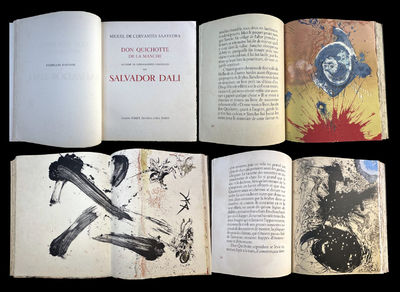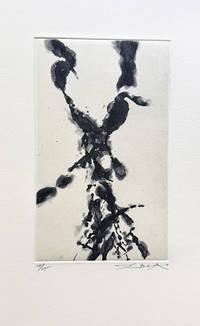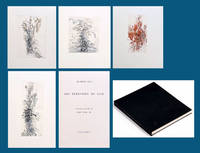Bound in full black morocco with the title gilt on both the spine and the cover. Gilt top edge, purple moiré silk endpapers. Th
1957 · Paris
by Miguel de Cervantes Saavedra
Paris, Joseph Foret, 1957. From the masterpiece by Miguel de Cervantes Saavedra Don Quichotte de la Manche, selected pages illustrated with 12 original lithographs in color by Salvador Dali, three of which are double-page spreads. One of few exemplare d'artiste with two extra suites of prints one in Velin d'Arches and one in Japan Nacre, totaling 36 lithographs, Bound in full black morocco with the title gilt on both the spine and the cover. Gilt top edge, purple moiré silk endpapers. The original cover and spine have been preserved by master bookbinder Jean-François Barbance.
Total limited edition of 197 copies plus 10 out of commerce numbered in Romans H.C. I to X along with a few artist's proofs. 25 copies also printed by Libreria Amateur numbered A to Z
The lithographs are exceptional and singular in their technique: the artist created the illustrations directly on lithographic stones and zinc plates—not with traditional tools like brushes or pencils, but using unconventional materials such as arquebus bullets, snails, insects, small toads, gravel, clay balls, putty, paper, eggs, and even sea urchins. Some plates feature as many as 20 colors, despite an original plan for only 5 or 6.
Dalí also instructed that certain projected images be transferred to stone before he drew the main figures. As noted by the artisans and master lithographers involved, these lithographic "collages" represent an unparalleled and inimitable artistic feat.
Dimensions: 42 x 34 cm
(Reference: Dalí (S.) – Déon (M.), History of a Great Book, Don Quixote illustrated by Dalí, J. Foret, 1957, p. 74. (Monod – 2448))* (Inventory #: N - 2025 - 75)
Total limited edition of 197 copies plus 10 out of commerce numbered in Romans H.C. I to X along with a few artist's proofs. 25 copies also printed by Libreria Amateur numbered A to Z
The lithographs are exceptional and singular in their technique: the artist created the illustrations directly on lithographic stones and zinc plates—not with traditional tools like brushes or pencils, but using unconventional materials such as arquebus bullets, snails, insects, small toads, gravel, clay balls, putty, paper, eggs, and even sea urchins. Some plates feature as many as 20 colors, despite an original plan for only 5 or 6.
Dalí also instructed that certain projected images be transferred to stone before he drew the main figures. As noted by the artisans and master lithographers involved, these lithographic "collages" represent an unparalleled and inimitable artistic feat.
Dimensions: 42 x 34 cm
(Reference: Dalí (S.) – Déon (M.), History of a Great Book, Don Quixote illustrated by Dalí, J. Foret, 1957, p. 74. (Monod – 2448))* (Inventory #: N - 2025 - 75)





